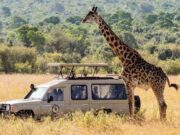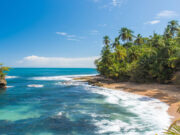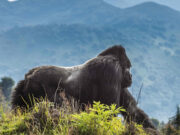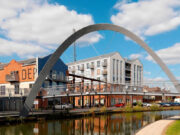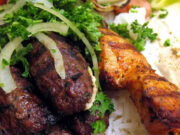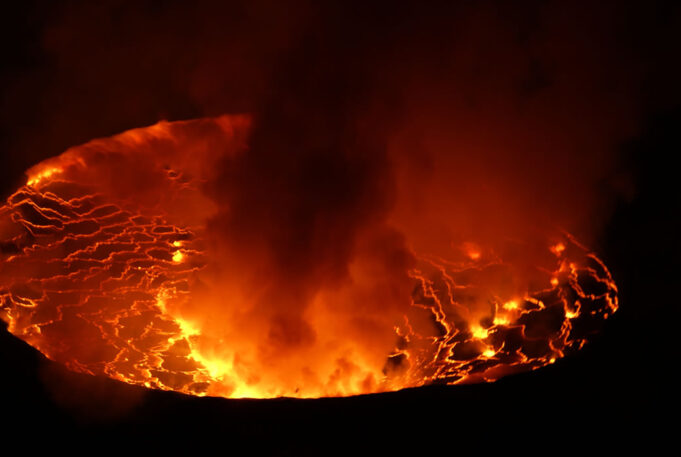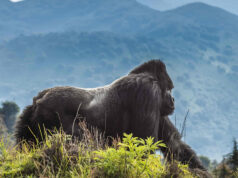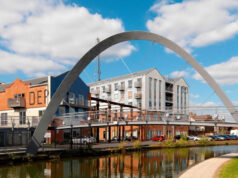The Democratic Republic of Congo is a country with great natural resources and wonders. Apart from gold, diamonds and oil, the Congo has over 15 other mineral resources. I should point out at this point that the uranium ore used to build the first atomic bombs were got from the Shinkolobwe Mines in the country. Minerals aside, Congo is a paradise for wildlife and nature lovers. From Africa’s big 5 animals to birds and reptiles, the country has it all. The Congo is home to wildlife species found nowhere else on earth including the elusive okapi, bongo, bonobos (pygmy chimpanzees), Congolese Peafowl, eastern lowland gorillas and mores. It is only in the Congo where tourists go on gorilla safari can track both wild mountain gorillas and Grauer’s gorillas (Eastern Lowland gorillas). Other beautiful attractions include active volcanoes, waterfalls.
There are also incredible cultural experiences with tribes like the Mbuti Pygmies. These pygmies still live like they used to over 10,000 years ago. Stay with the Mbuti pygmies for a week and you will go back home with amazing stories to tell your friends. Cultural experiences aside, there are also amazing physical features like the Nyiragongo Volcano. The experience of observing the boiling Magma on top of these mountain revivals any game drive you will do in the Masai Mara or the Serengeti National Park. But there is more. Congo is blessed with amazing waterfalls and endless rivers. Following the river Congo by boat for a month will give you an opportunity to appreciate the country’s natural beauty and tourism potential.
There is great hope for the country and things are improving. Increased globalization means the Congo cannot be left behind. Soon the rebels and militias will be no more and when that happens, people will begin realizing what they have been missing. There are many who predict that the Democratic Republic of Congo will become one of the most visited countries in Africa in the near future.
Virunga National Park
Virunga is the oldest national park in Africa and one of the many UNESCO World heritage sites in the Democratic Republic of Congo. The park was established in 1925 and is located in the eastern part of the country. Virunga was at first named Albert National Park and by then included the Volcanoes National Park in Rwanda and parts of Mgahinga Gorilla Park in Uganda. Virunga is the most visited national park in the Democratic Republic of Congo. What stands out about it apart from volcanoes and mountain gorillas is the remarkable biodiversity. Virunga is home to lions, leopards, chimpanzees, elephants, hippopotamus and rare creatures like the okapi. Gorilla trekking in Virunga National Park is the most popular activity followed closely by hiking Mount Nyiragongo.
Mount Nyiragongo
The Nyiragongo Volcano is one of the key attractions in Virunga National Park and its plumes of smoke can be seen from as far as Rwanda during the night. Nyiragongo is an active volcano with the largest lava lake on earth. Ever since 1984, the mountain has erupted 34 times with the last occurring in 2011. Every year thousands ignore the bad press and security reports from their embassies for a chance to call themselves as one of the few who have observed a lava lake up-close. When combined with gorilla trekking in Virunga and visiting the Serengeti/Masai Maraa, you would have done something that you can talk about with pride to your folks back home. Climbing Mount Nyiragongo takes two days and you will be left in awe at the sight of the lava lake. Nyiragongo hiking tickets cost $300 per person including a night spent on cabins while at the summit.
Senkwekwe Gorilla Orphanage
After visiting the gorillas in the wild, tourists who book with Mikeno lodge have an opportunity to visit the Senkwekwe Gorilla Orphanage. This is the only Mountain gorilla orphanage in the world and about 7 individuals call it home. The center also rehabilitates Eastern Lowland gorilla orphans for a while before relocating them to the Eastern Lowland gorilla orphanage known as the Gorilla Rehabilitation and Conservation Education Center. The center was named after a giant silverback known as Senkwekwe. Senkwekwe was killed by poachers as he attempted to protect his family and recover an infant captured by animal traffickers.
His death and the capture of other infant gorillas laid the foundation for the establishment of this center. The Center is set on a stretch of forest allowing the primates to experience the same conditions of their wild relatives. The Senkwekwe Gorilla Orphanage welcomes volunteers who are interested in learning more about mountain gorillas. If you are enthusiastic about gorilla conservation, you can sponsor one of the gorilla orphans or donate to the Sanctuary. Visiting the Center is free to tourists residing in the luxury Mikeno Lodge.
Maiko National Park
Maiko National Park covers an area of about 10,885 square kilometers. Most of it is forest and an important global carbon sink. Like most of the National parks in the country, it is located in a very remote area. In fact, it is Congo’s most inaccessible game park. The park consists of 3 sectors – Maniema, Province Orientale and North Kivu. Maiko National Park is one of the last strongholds of the Grauer’s gorilla – also known as the Eastern lowland gorillas. These are the largest subspecies of gorillas. Other animals endemic to the Congo but found in Maiko include the Congo Peafowl and Okapi. Maiko National Park is an important conservation site for aquatic genet, chimpanzees and African forest elephants. Visitors should also look forward to spotting leopards and the elusive bongo.
Kahuzi-Biega National Park
This national park is found in found in the Eastern part of the Democratic Republic of Congo – near the border with Rwanda and close to Lake Kivu. Kahuzi-Biega National Park National Park is another of the many UNESCO World heritage sites in Congo. The gets its name from two extinct volcanoes known as Kahuzi and Biega. These two volcanos paint the landscape and are joined together by a small stretch of forest. Kahuzi-Biega National Park offers travelers that complete wilderness charm and feeling that only the Congo can provide these days. The park is an excellent travel destination for travelers who desire to do something different or discover Africa’s last remaining true wildernesses.
Other than pristine wilderness, Kahuzi-Biega National Park is one of the last strongholds for the largest gorilla species on earth – the Grauer’s gorilla. About 400 individuals are found in the park with others found in Maiko National Park and some other reserves in the neighboring areas. In total, about 5,000 Eastern lowland gorillas remain on earth and they are all found in the Democratic Republic of Congo. Interestingly, despite not having the largest population of the primates, Kahuzi Biega is the best place to see the Eastern Lowland gorilla. Eastern lowland gorilla trekking is the most popular activity but tourists can also register for chimpanzee tracking, visiting the chimpanzee sanctuary in Lwiro, birding, mountain hiking and nature walks to discover amazing waterfalls.
Salonga National Park
Salonga National park is located within the Congo River basin and covers an area of about 36, 00 square kilometers. It is a UNESCO World Heritage site because of the dense forests and remarkable creatures that call it home. The tropical rain-forest which makes up much of the national park is so dense that new species are still being discovered. The park was declared a World Heritage site in danger since 1999 because of continuous civil wars in the eastern Congo. These civil wars have allowed poaching for bush meat to thrive. Regardless of the civil wars and poaching, Salonga remains a major tourist attraction for the future because of its extensive forests and remarkable biodiversity. Among the wildlife found in the park include the rare Congo peafowl, forest elephants, bonobos, salonga monkeys, Tshuapa red Colobus monkeys, okapi and the African slender-snouted crocodile. The road networks within and outside the park is poorly developed. Because of that, the only way to access the park is via the river.
Garamba National Park
Garamba is a UNESCO World Heritage site for its collection of plant and animal life. The park was established in 1938, making it one of the oldest national parks in Africa. The park consists of endless savannah grasslands and woodlands which continue all the way to South Sudan and the Central African Republic. Garamba once home to over 20,000 African elephants but now only about 1,500 remain. Extensive poaching may soon wipe out the last known population of White Rhinos if conservationists lower their guard. Garamba is arguably the best par for standard game drives in the Democratic Republic of Congo. Visitors can view all the big 5, giraffes, hippos, antelopes and birds.
Lake Kivu: Lake Kivu is one of the largest lakes in Africa. It is shared by Rwanda and the Democratic Republic of Congo. Lake Kivu lies next to the great Virunga and Kahuzi-Biega National Park. Under the lake is a large reservoir of methane gas which scientists believe is a disaster waiting to happen if the right conditions present it or if a volcanic eruption occurs among one of the Virunga volcanos. After a long safari in Congo or Rwanda, Lake Kivu is excellent for relaxation, swimming, island hopping, visiting local fishing communities, canoeing, kayaking, biking and other water spots. Fishing is also possible and the main catches are Nile Tilapia, Tanganyika sardines, Clarias, Haplochromis, Barbus and Limnothrissa miodon. There are no hippos, crocodiles or bilharzia to worry about while swimming in Lake Kivu.
Idjwi Island: Also known as Ijwi, the island is found in Congo’s section of Lake Kivu. The Island covers an area of about 340 square kilometers and is considered the 2nd largest inland island in the continent of Africa. Idjwi Island is home to about 200,000 people. Most of them survive on subsistence farming and small scale fishing. Idjwi Island became a kingdom in the 18th Century and had a connection to the ruling monarchy Rwanda at the time. Tourists who visit the Virunga and Kahuzi-Biega National Parks often visit the island for cultural tours, hiking and also to explore the beautiful Lake Kivu. Boat rides to the island from Bukavu (near Kahuzi-Biega National Park) takes about 2 hours. Once there, the only means of transport is by bike, motorcycle or walking.
Okapi Wildlife Reserve: The Okapi Wildlife Reserve is one of the many beautiful attractions and UNESCO World Heritage sites in Congo which have been hidden way from much of the world. The reserve covers about 14,000 square kilometers and one fifth of it consists of dense forest. Okapi Wildlife Reserve rewards those who are fortunate enough to visit with amazing scenery, a chance to observe the elusive okapi, other wildlife species, waterfalls and a cultural encounter that is second to none in Africa. To find the elusive okapi, one needs at least 3 days in the Ituri forest. The search is interesting because it is led by Mbuti pygmies. They are the ones who know the secrets of the forest and can locate the okapi using instinct or small leads. While tracking the okapi, the pygmies will introduce you to their lifestyle of hunting and gathering in the forest.



